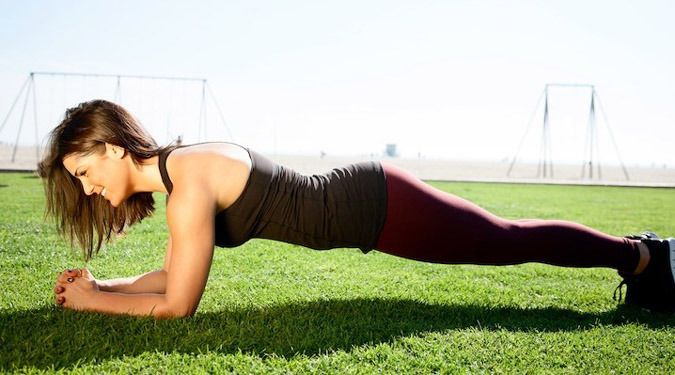
If you’re interested in using your own body weight to get fit and functional, but don’t know exactly what muscles does the plank work, this article gives you a refreshing look at one of the best forms of exercise out there!
The Flat-Out Planking Truth
At the end of the day planking, in all of its glorious forms, can work every single solitary muscle in the body. From the Adductor Hallusic of the big toes to the traps, planks almost have no limits. In essence planking is the act of suspending the body above ground somehow and using the muscles (along with leverage) to fight against gravity.
SEE ALSO: The Plank Exercise – What You Need to Know
Furthermore, typical planks are considered a stationary exercise. Most people don’t do other things while they plank. Instead, they look a lot like the guy in this explanation of how to do a plank.
- The conventional plank is considered to be a core exercise and there are four ways to do it on the ground: front, both sides for the obliques and then reverse where the glutes face downward.
- Some folks do it with their elbows touching the ground along with their forearms, while others either sit in a modified or full extension pushup position.
- In reality much more than just the Lumbo Pelvic Hip Complex is engaged, including the glutes, the majority of the legs as well as the neck. Tension runs pretty much throughout the musculature of the body.
- Planks also work the muscles that line the pelvic floor (see also: Pelvic Floor Strong – Full Review) which can help decrease the occurence of bladder leaks, fecal incontinence and more.
Progressive Planking: 10 Ways People Work Their Entire Body
There is a large array of planks, far beyond the conventional four positions that fitness lovers prefer and practice for 30-60 seconds per set. Let’s take a look at ten of them.
- Incline/Decline Planks: Instead of being parallel to the ground, it’s incredibly easy to add either an incline or decline to the stationary plank.
- Dumbbell Assisted Planks: You could do planks with dumbbells in your hands and use them to boost the difficulty level by doing things like shoulder raises or rows.
- Incorporated Planks: Rather than doing planks all by themselves, people include a planking position into other types of exercises. For example pushups or even burpees.
- Moving Planks: These days you’ll see people moving around while they keep their body in a plank position. As long as the body is suspended against gravity, the core and overall musculature are engaged.
- Circuit Planks: Because so many people are losing body fat while they train their core, it’s really popular to integrate planks into a circuit-based routine.
- The L-Sit: The L-sit with progressions is incredibly hard, and the most common people that practice it are gymnasts. Like the conventional plank, there are many different versions. Here is a great breakdown on an L-sit progression that works.
- The Planche: Like the L-sit, this is a rather challenging type of plank that few people dare to conquer. However, it will strengthen the core and enhance overall body control unlike anything else. It takes lots of time and practice. If you’re interested, check out this in-depth look at planche training.
- Proprioceptive Planks: This is where you do some form of plank using a device that taps into your internal balance and stabilization mechanisms. It could be anything from a Bosu to a stability ball.
- Yoga Planks: Planking is a huge part of many different Yoga positions. In fact, one could argue that planking is the foundation of Yoga.
- Hanging Planks: Why not take a plank from the ground and do it in their air? Try hanging from a pull up bar and keeping the legs held straight out in front for 30 seconds without letting them drop one inch.
A Complete Planking Body Overhaul
Right, so obviously there are no muscles that escape the reach of planks. If one were so inclined they could do away with resistance training altogether and use planks to condition their body.
Plenty of people do! Especially since there are fewer folks these days with discretionary income to spend on physical trainers and gym memberships.
And another thing, planking is completely safe unless you’re doing some sort of insane stunt. No planking between two buildings or anything.
More Stuff Like This
Looking for more core-related goodness? Below are some more articles and buyer’s guides to all things abs and core.
5 Best Ab Rollers for a Strong and Ripped Mid-Section. Ab rollers are your best weapon for strong and ripped mid-section. Here is a breakdown of the best ab rollers for your home gym.
6 Best Ab Mats for a Strong Core and Six-Pack. Ab mats are a powerful weapon for punishing your core, building a strong mid-section, and yup, sharpening that six-pack. Here’s everything you need to know about picking the best abdominal mat for training your core.
6 Best Ab Benches for a Chiseled Mid-Section. The best ab benches are compact, versatile, and have all the features you want for your core workouts. Here are the top ab benches for your home gym.
The Best Core Sliders for Building a Rock-Hard Midsection. Core sliders are a killer tool for a strong core. Here’s a look at the best ones on the market.